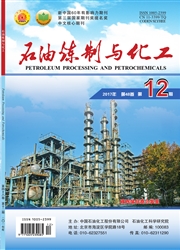

 中文摘要:
中文摘要:
使用不同的酸性试剂(柠檬酸、磷酸、硝酸)对活性炭进行改性,利用BET、红外光谱、SEM等手段对样品改性前后结构进行了表征,并在固定床反应器上对其在乙炔氢氯化反应中的催化活性进行了测试。实验结果表明:使用不同的酸性试剂进行改性时,各样品的孔道结构和表面化学性质不同,并不同程度地提高了催化剂的活性。用硝酸改性后,比表面积及孔体积有所降低,但平均孔径有所增大,因大大提高了表面含氧酸性基团的含量,催化剂活性最好,其初始转化率可达到71.8%;用磷酸改性时,比表面积下降最大,但因引入了磷酸根使活性增加;当用柠檬酸改性时活性增加不大。另外,由于硝酸的强腐蚀作用,用硝酸改性时,过高浓度或处理时间过长不利于提高催化剂的活性,浓度为5mol/L为宜,时间为6h最佳。
 英文摘要:
英文摘要:
The activated carbon (AC) HNO3). The pore structures and surface was modified by different acidic reagents (H3 PO4 , C6 H8O7, chemistry of the samples were characterized by BET, FI-IR, and SEM techniques. The catalytic performance in acetylene hydrochlorination was investigated in a fixed bed reactor. The experimental results show that the pore structures and surface chemistry changes with different acidic reagents though catalytic activities are all increased at various degrees. When nitric acid is used as a modifier, the surface area and pore volume decrease compared to untreated AC, while the average pore diameter increases. The activity of the nitric acid modified catalyst is the best due to greatly improve the content of oxygen-containing acidic groups. The conversion of acetylene is up to 71.8% ; when phosphoric acid is used as a modifier, the reduction of specific surface area is the largest, whoever, its activity increases because of the introduction of phosphate. The activity of the catalyst treated with citric acid does not increase. In addition, it is found that high concentration of nitric acid or too long time treating does not help to improve the activity of the catalyst due to a strong corrosion of nitric acid. The catalytic activity is the best at nitric acid concentration of 5 mol/L and 6 h.
 同期刊论文项目
同期刊论文项目
 同项目期刊论文
同项目期刊论文
 期刊信息
期刊信息
